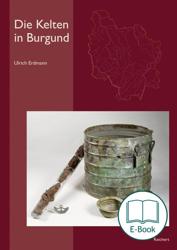Der Band fasst Erkenntnisse über die keltische Phase der burgundischen Vergangenheit zusammen und gibt Hinweise, wo man Keltisches noch betrachten kann. Am Anfang des Bandes stehen als Glanzlichter die in Hügelgräbern gefundenen wertvollen und kunstvollen Erzeugnisse etruskischer und griechischer Herkunft. Sie zeigen Analogien zum Leben griechischer Helden und Parallelen zu den „Fürstensitzen“ Südwestdeutschlands. Spuren von Handel und Handwerk weisen weiträumige Verbindungen auf, die später auch auf militärischem Gebiet anzutreffen sind. Burgund nimmt an der Ausbreitung des über das ganze Europa nördlich der Alpen verbreiteten latènezeitlichen Stils und an der Entwicklung der stadtähnlichen Siedlungsform der „oppida“ teil. Für diese Zeit erlaubt das Material einen Einblick in politische Strukturen, in Gesellschaft und privates Leben, die sich bei der Transformation in eine römische Provinz durchgreifend ändern sollten. Eine Reihe von Fundstätten wird gesondert betrachtet.
For Burgundy the Celtic past can be presented much better than for other regions – for two reasons. The high level of documented research gives us a great amount of detail for two exemplary sample sites, for Mont Lassois (Vix) representing the Fürstensitz type of settlement, and for Bibracte (Mont Beuvray) representing the oppida system. And, secondly, it is a fortunate incident of surviving ancient literature that Gaius Iulius Cesar’s report on the Gallic war provides insight into the political structure and Iron Age society of East Central France in the first century BC, which we lack for other regions of Iron Age settlement.
Initially, precious and prestigious objects of Etruscan and Greek origins from tumuli, as well as weaponry – with similarities to south west Germany and Switzerland – show analogies to the life of Greek heroes. Photographies of samples from the regional museums of Burgundy and from the central national museum of archaeology in Saint-Germain-en-Laye near Paris are presented for illustration.
Not before the second half of the last millennium BC individual Celtic tribes become visible as migrants and warriors in Italy, Eastern Europe and Asia Minor, constantly involved in battle.
Crafts and commerce indicate a great variety of contacts with other regions, with their neighbours in Britain as well as with distant places like the Baltic and the Mediterranean. Burgundy is part of the La Tène style of decoration expanding all over Europe north of the Alps, and of the developments leading to the formation of the town-like oppida. For this period sufficient material is available to distinguish some features of political structures, society (leading elites, druids), and the private life, all of which were to change drastically during the transformation into a province of Rome; even the language was to fade away.
The great variety of Celtic life in Burgundy and its change over time is documented in a presentation of over twenty individual site locations and areas.
„(Der Band hat den) Charakter eines Handbuchs. Über die Hälfte des, Werkes ist allgemeinen Problemen der keltischen Periode des späteren Burgund gewidmet. (...) Insgesamt handelt es sich um zwei herausragende Publikationen, die in systematischer, fundierter anschaulicher und gut lesbarer Form die bisher vernachlässigte Geschichte des burgundischen
Raums in der Antike nahebringen. Sie sind jedem an der Geschichte der burgundischen Landschaft Interessierten mit Nachdruck zu empfehlen.“
Franz Quarthal
In: Schwäbische Heimat, 2014. Heft 2, S. 232-233.
--------------------------------------
„Für wenige Gegenden lässt sich ihre keltische Vergangenheit so gut darstellen wie für Burgund. Ein hoher Forschungsstand liefert detailreiche Berichte für den Fürstensitz auf dem Mont Lassois (Vix) und für das Oppidum Bibractc (Mont Beuvray). Ausserdem ist es ein Glücksfall der Überlieferung, dass Gaius Julius Caesars Bericht über den gallischen Krieg für das 1 Jh. v. Chr. Einblicke in die politischen Strukturen und die keltische Gesellschaft des östlichen Zentralfrankreichs gestattet, die für andere keltische Siedlungsgebiete fehlen. Eine gesonderte Darstellung von über zwanzig Fundorten und Gebieten lässt die Vielfalt und den Wandel des keltischen Lebens in Burgund erkennen.“
Von Dr. Rudolf Degen
In: helvetia archaeologica, Heft 175/176, Jahrgang 44. 2013.
Pour la Bourgogne on peut établir son passée celtique mieux que pour autres régions.
Le niveau important dans la recherche offre de nombreux rapports détaillés visant notamment deux lieux de découverte le Mont Lassois (Vix) concernant le type Fürstensitz et Bibracte (Mont Beuvray) concernant le système des oppida. Et c’est une chance que par la transmission du rapport sur la guerre des Gaules au premier siècle avant J.-C. Gaius Julius César a permis un aperçu des structures politiques et de la société celtique au centre oriental de la France, qui n’existe pas dans d’autres régions celtiques européenes.
Au début des objets de prestige précieux et somptueux d’origine étrusque et grec émanant de tumulus comme des armes, semblables aux découvertes en Allemagne du sud-ouest et en Suisse ressemblent à la vie d’héros grecs. Des exemples de musées régionaux en Bourgogne et du musée d’Archéologie nationale à Saint-Germain-en-Laye près de Paris sont présentés au lecteur.
C’est seulement dans la deuxième moitié du dernier millénaire avant J.-C. que l’on peut reconnaître en Italie, dans l’Europe orientale et l’Asie mineure des groupes celtiques venant des territoires aujourd’hui la France, peuplades migratoires et des soldats. Constamment en guerre.
Finalement des objets d’artisanat et de commerce sont une preuve des liens avec la Grande Bretagne voisine comme avec des contrées éloignées de la mer baltique et de la mer méditerranéenne. La Bourgogne participe à l’élargissement à travers l’Europe au nord des Alpes du style décoratif de l’époque La Tène et au développement des oppida. Le matériel permet un regard sur les structures politiques, la société (élite du gouvernement, druides) et la vie privée de cette époque qui changeront fondamentalement lors de la transformation en province romaine ; même la langue se meurt.
Une représentation détaillée d’environ vingt lieux et régions de fouilles permet de découvrir la diversité et le changement de la vie celtique en Bourgogne.


 Table of Contents
Table of Contents